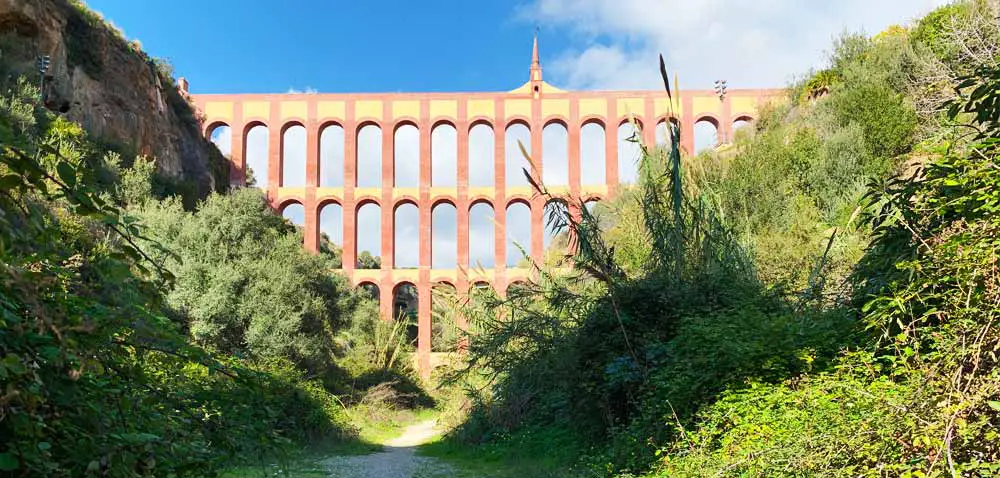The Eagle Aqueduct
The Eagle Aqueduct ➜ Everything You Should Know
🦅 Balancing delicately along a gorge between Nerja and Maro is one of Nerja's top sites and one that deserves your attention... and maybe a few photos!We all know that Spain at one time was part of the Roman Empire, and that the Romans left their mark on the area with the construction of amazing aqueducts and bridges along the coast (some of which can still be seen today in neighboring Almuñécar). But surprisingly, the Romans did not build the Eagle Aqueduct. This incredible feat of architecture was actually built in the 19th century using the same methods and styles that the Romans and Moors once claimed as their own.
The Eagle Aqueduct ➜ Where is it?
You will find the Eagle Aqueduct just 2.5 km east of the village of Nerja in the smaller municipality of Maro. It is hidden between the two sides of the Barranco de la Coladilla (Coladilla Gorge) on your left-hand side going towards the Nerja Caves.
Distances to nearby cities / towns in Andalucia:
| Nerja | ➜ | Eagle Aqueduct | 4 min (2.4 km) |
| La Herradura | ➜ | Eagle Aqueduct | 18 min (16.2 km) |
| Málaga | ➜ | Eagle Aqueduct | 46 min (59 km) |
| Granada | ➜ | Eagle Aqueduct | 1 hr (91 km) |
The History of the Eagle Aqueduct
The history of Nerja and the Eagle Aqueduct is based around nearly one-thousand years of sugar cane production!During the period of the Muslim Dynasty in Granada, most of the coast was covered in sugar cane plantations. These plantations supplied sugar to the kingdom which greatly aided the local economy.
As time went on, and especially during the industrial revolution, sugar mills were built along the coast to aid in production of this important local commodity.
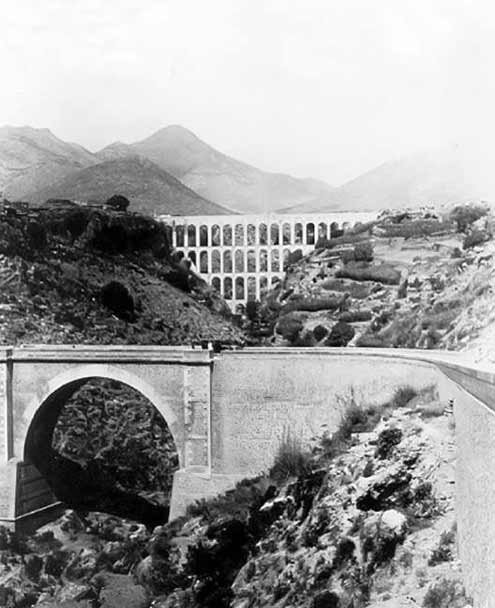
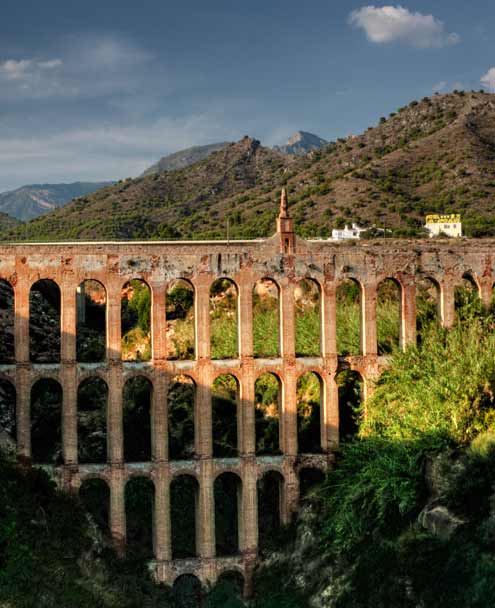
** The Eagle Aqueduct - Before the Reforms
Note: Three related sites that can be visited nearby in Motril are the 'Museo Preindustrial del Azucar', the 'Motril Sugar Warehouse', and the 'Ron Montero Bodega' (where you can sample rums made from local sugar cane... 👍).
Eagle Aqueduct Facts:
- The Eagle Aqueduct was built in 1880 and was used to move water between the village of Nerja and the San Joaquin Sugar Mill in Maro.
- It was commissioned to be built by the factory owner at that time, Francisco Cantarero Senio... his signature is still visible on the central pavilion of the aqueduct.
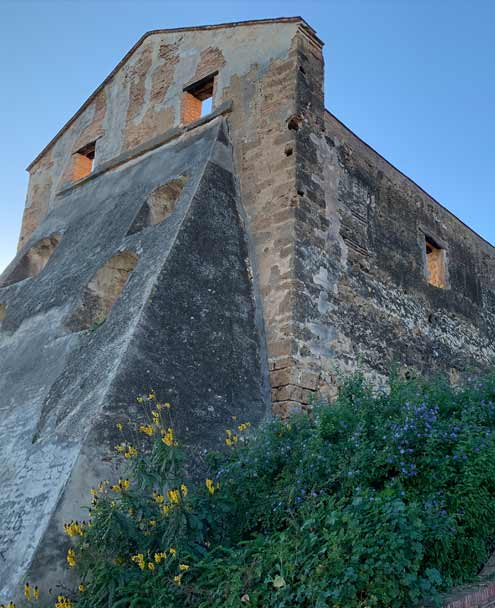
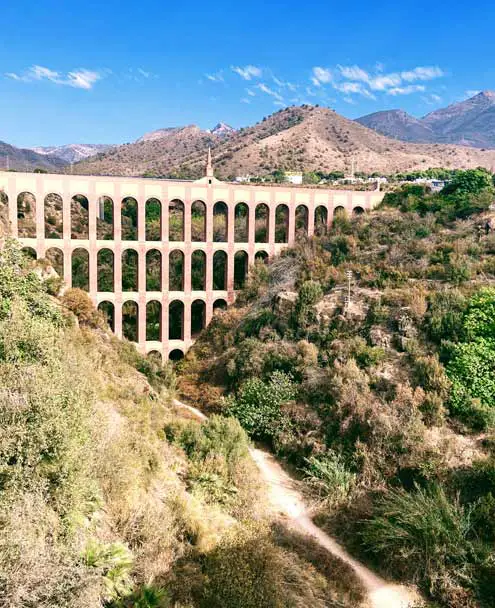
** The Eagle Aqueduct Today - Nerja
- The sugar factory is no longer in use but the aqueduct is currently being used for irrigation to nearby farms.
- During the Spanish Civil War, the Eagle Aqueduct and the Nerja Castle were severely damaged by direct hits from naval bombardments. The castle was located at the end of the Balcon de Europa promenade.
- The Junta de Andalucia repaired much of the damage to the Aqueduct in 2011 as well as giving it a bit of a 'facelift' by painting the brick around the arches yellow.
The Eagle Aqueduct has been formally recognized by the government of Andalucia as a "Site of Special Cultural Interest".
The Eagle Aqueduct ➜ The Design
- The Eagle Aqueduct was built in the Mudejar style. Mudejar refers to the Muslims who remained in Spain after the Christian reconquest. The Mudejar style is used to describe a style influenced by Islamic art, but typically created by Christian craftsmen.
- The architect, Francisco Cantarero Martín, was a local man who was born in Nerja.
- The aqueduct consists of four stories of brick columns and arches (37 arches in total, 40 meters tall, and 90 meters wide).
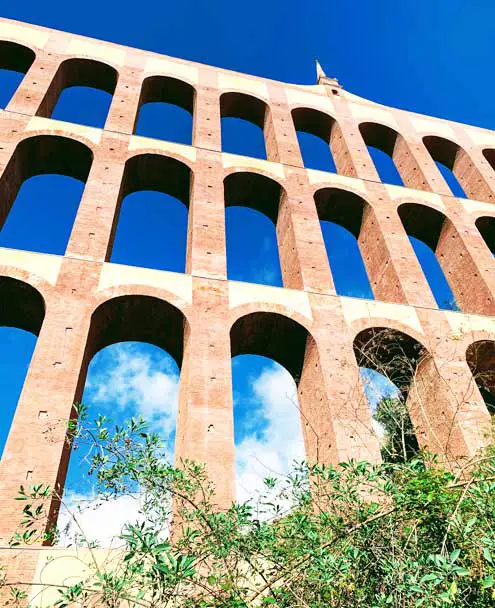
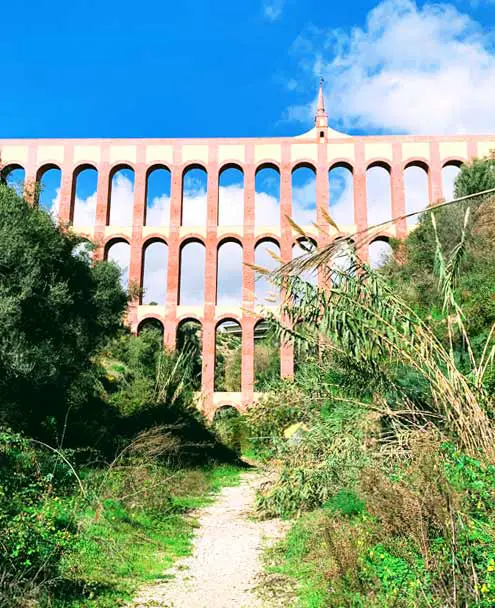
** The Eagle Aqueduct's 37 Arches Today - Nerja, Spain
- At the tip-top, and a little off-center, you will see a spire capped with a double-headed eagle weathervane. No one knows exactly why the symbol of the eagle was used in the design... but it is how the Eagle Aqueduct 🦅 received its name.
- The front of the Aqueduct faces north towards the Sierras de Tejeda, Almijara y Alhama Natural Park. It is possible to take the path below and view the other side of the structure.
- A plaque with the inscription "Pura Y Limpia Concepción" (Pure and Clean Conception), was placed on the front.
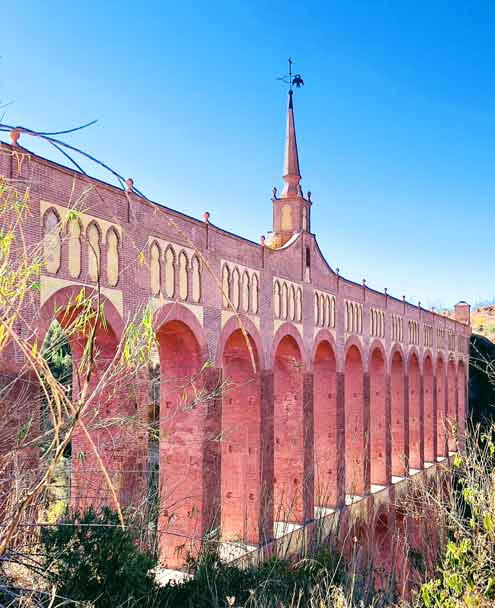
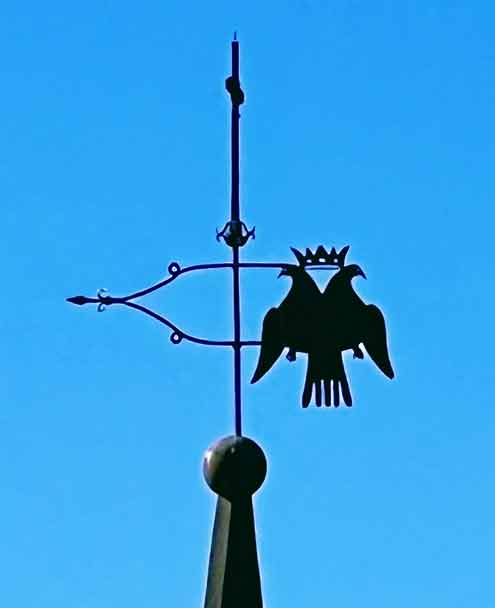
** The Front Face of the Eagle Aqueduct & Double Headed Eagle
Other Nearby Sites:
The Eagle Aqueduct ➜ How to Best View it
The Eagle Aqueduct can be seen in one of two ways...
- Driving towards Maro from Nerja take the Maro exit on the main roundabout heading out of town. Immediately after the roundabout you will pass over a bridge where the Eagle Aqueduct can be viewed. There are small areas on both sides of the road where you can stop to take photos.
- If you are a little more adventurous, you can walk to the aqueduct and see it up close.
Just after the bridge, on the right, there is a small road. Take this road until you reach a smaller stone bridge. On the opposite side of the bridge, you will find a path that leads to the Eagle Aqueduct.
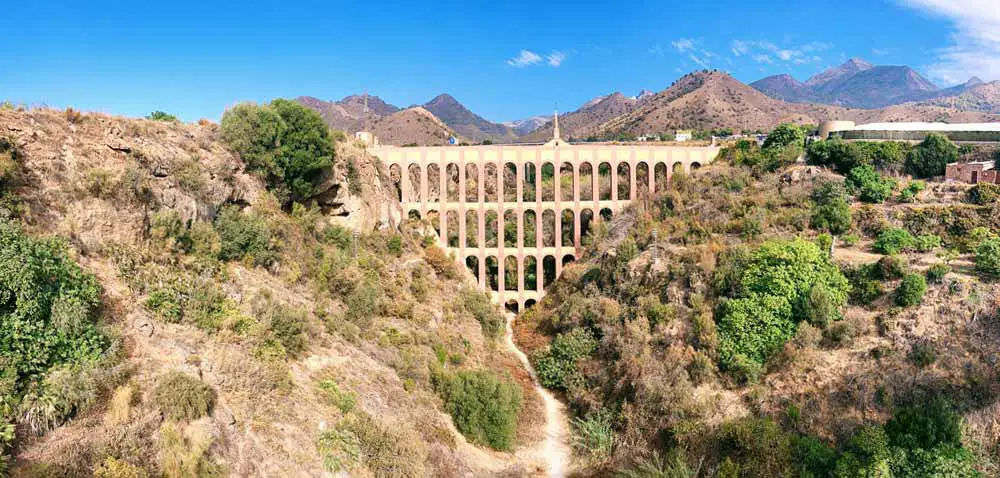
** The Eagle Aqueduct from a distance - Nerja
The Eagle Aqueduct ➜ How to Arrive - Directions
| To the Eagle Aqueduct ➜ by Car
|
| To the Eagle Aqueduct ➜ by Bus Buses leave hourly from Nerja to Maro. Tickets can be purchased directly from the ticket booth at the Nerja Bus Station (Avenida Pescia) map here
|
| To the Eagle Aqueduct ➜ by Taxi There are three taxi stations in Nerja or you can call Radio Taxi, the official taxi service (952 520 537). The price by taxi to Maro is about €8.00.
|
| To the Eagle Aqueduct ➜ by Train A fun way to get from Nerja to Maro is by taking the Nerja Tourist Train. It makes two stops, Maro and the Nerja Caves. You can get off the train in Maro and then walk 5-minutes to the Eagle Aqueduct. From there walk back up the hill about 8-minutes to visit the Nerja Caves.
|
| To the Eagle Aqueduct ➜ by Foot Many people love to make the walk from Nerja to Maro (where they can visit both the Eagle Aqueduct and the Nerja Caves). It will take you at least 45-minutes each way (3.5 km). It's a completely flat walk with a sidewalk the entire way.
|
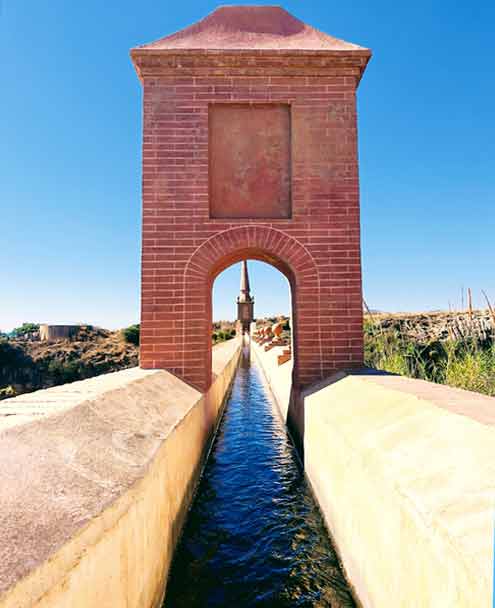
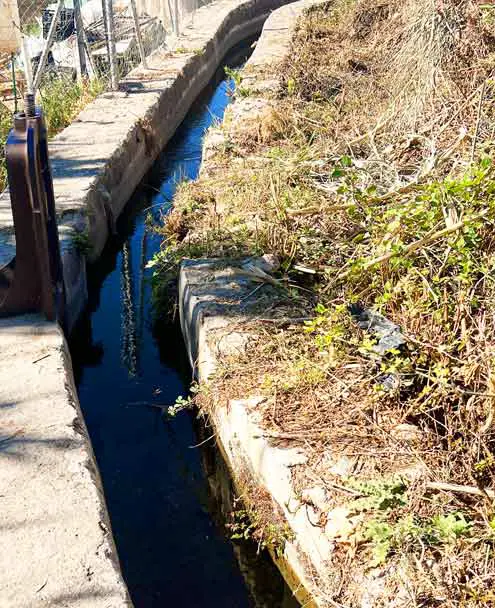
** The Eagle Aqueduct's Irrigation System & Nearby Water Canals
The Eagle Aqueduct ➜ What can you do nearby?
- The Village of Maro: From the Eagle Aqueduct, walk 5-minutes to the center of Maro. It's a tiny, white-washed town typical of what you find in Andalucia. There you can visit the Iglesia de las Maravillas, the remains of the San Joaquin Sugar Mill (mentioned above) and enjoy a light lunch in the plaza.
- The Nerja Caves: Walk back towards Maro from the Eagle Aqueduct and take a left going up the hill and under the highway. The Nerja Caves will be straight ahead and are absolutely worth a visit. ➜ The Ultimate Guide to the Nerja Caves
- Cala Barranco de Maro: 🏖️ This is not an easy walk because the path is overgrown in parts but it is
flat and will only take about 30-minutes.
If you followed the path down to the bottom of the gorge towards the Eagle Aqueduct, turn around and go in the direction of the sea. The path will lead you all the way to a tiny pebble beach (Cala Barranco de Maro) that most people don't know is there.
- The Beaches in the Maro Nature Reserve: 🌴 Just beyond the village of Maro lie 10 lovely virgin beaches that are just waiting to
be enjoyed! They stretch from Maro all the way down the coast to La Herradura.
It's best if you have a car, but it would be possible to walk to either Playa de Maro (2.6 km, 35-min walk from aqueduct) or Playa la Caleta de Maro (2.3 km, 31-min walk from aqueduct).
Parador de Nerja -
Hotel Balcón de Europa -
Hotel Riu Monica - Adults Only -
Marinas de Nerja Beach & Spa -
MB Boutique Hotel -
Save money on your next trip with our favorite travel websites!
| Find the Cheapest Hotels: | |
| The Largest Selection of Villas & Apartments: | |
| Cheapest, Most Reliable Car Rentals: | |
| Best Bus & Train Fares: | |
| Huge Selection of the BEST Tours & Activities | |
| Discount Tickets to Museums & Attractions | |
- The Nerja Caves
- Prices
- Tour Packages
- Opening Hours
- The Nerja Museum
- The Nerja Tourist Train
- Tours to Nerja & the Nerja Caves
- Nerja's Top Sites
- Balcón de Europa
- Eagle Aqueduct
- The Ermita de las Angustias
- The Church of El Salvador
- Top Things to Do
- Nerja Hiking Trails
- Visit the Nerja Markets
- Day Trips to Nerja
- Excursions From Nerja
- Costa del Sol Sailing Tours
- Kayaking in the Nature Reserve
- How to Arrive
- Getting From Malaga to Nerja
- Where is Nerja?
- Nerja to Frigiliana
- Nerja to Frigiliana Bus Info
